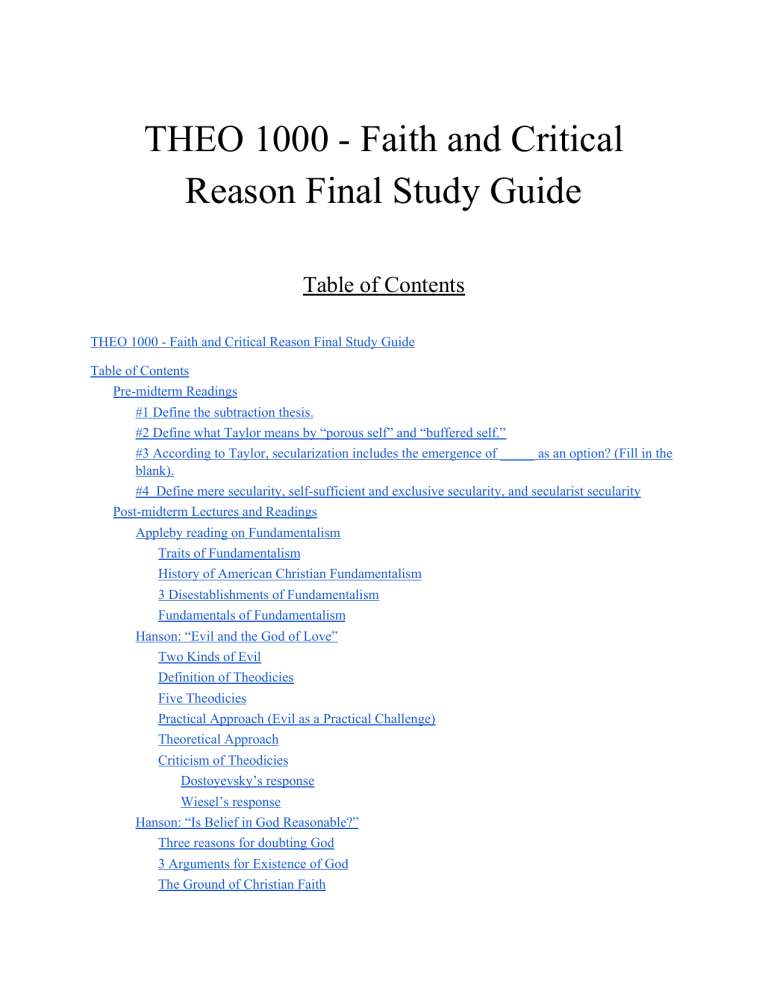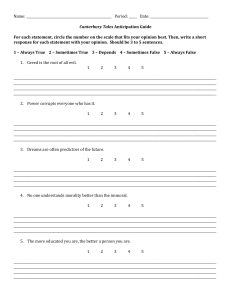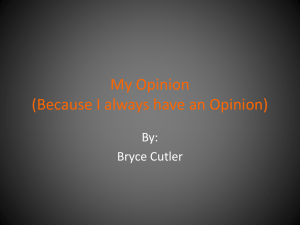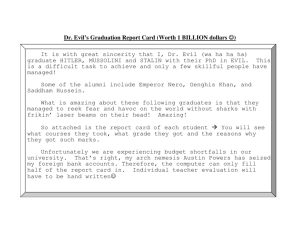
THEO 1000 - Faith and Critical Reason Final Study Guide Table of Contents THEO 1000 - Faith and Critical Reason Final Study Guide Table of Contents Pre-midterm Readings #1 Define the subtraction thesis. #2 Define what Taylor means by “porous self” and “buffered self.” #3 According to Taylor, secularization includes the emergence of _____ as an option? (Fill in the blank). #4 Define mere secularity, self-sufficient and exclusive secularity, and secularist secularity Post-midterm Lectures and Readings Appleby reading on Fundamentalism Traits of Fundamentalism History of American Christian Fundamentalism 3 Disestablishments of Fundamentalism Fundamentals of Fundamentalism Hanson: “Evil and the God of Love” Two Kinds of Evil Definition of Theodicies Five Theodicies Practical Approach (Evil as a Practical Challenge) Theoretical Approach Criticism of Theodicies Dostoyevsky’s response Wiesel’s response Hanson: “Is Belief in God Reasonable?” Three reasons for doubting God 3 Arguments for Existence of God The Ground of Christian Faith Does Jill need to defend her beliefs from people who don’t believe? Characteristics of Basic Beliefs Two Tests for Distinguishing Among Beliefs Three Angles of Belief Five Conceptions of Faith (Faith as…) Constitutive Aspects of Faith Pre-midterm Readings #1 Define the subtraction thesis. The subtraction thesis maintains that modernization and secularism will eventually result in the complete subtraction of religion from society. It holds that in the switch from enchantment to disenchantment, there is no epistemic loss in terms of knowledge. It merely results in a change in sensibility, in which “false” beliefs, fears, and imagined objects are cast aside and disproven. The only thing that is lost is a way in which we used to experience the world. Religion experiences a transition from a culture to becoming privatized. #2 Define what Taylor means by “porous self” and “buffered self.” Buffered self: describes living with a firmer sense of the boundary between self and other. A buffered self finds it harder to be frightened about the supernatural and easier to disengage from everything outside of the mind. The buffered self might say: “I am sad due to neurotransmitters,” or “I see that ad, and I like the item, so I will buy it.” Porous self: is vulnerable, open to being enchanted. The porous self might say “I feel sad, so God must be punishing me,” or “That ad is trying to control me and I must either ignore or succumb to it.” #3 According to Taylor, secularization includes the emergence of _____ as an option? (Fill in the blank). A: unbelief as an option. #4 Define mere secularity, self-sufficient and exclusive secularity, and secularist secularity mere secularity: Describes a secular world where being religious is a normal, viable option (United States) You’re religious? Cool. self-sufficient and exclusive secularity: Describes a world in which living without religion is normal and taken for granted (United Kingdom/England) You’re religious? Weird. secularist secularity: Describes living as liberated from religion as a condition for human autonomy and flourishing (France) You’re religious? You’re a drain on society. Post-midterm Lectures and Readings Appleby reading on Fundamentalism Traits of Fundamentalism Fundamentalism is often misconstrued as “radical” or “unorthodox,” but it is really a modern, anti-modern response that takes shape in the form of movements of opposition against the state. ● ● ● The five ideological traits of fundamentalism are split up into two categories: ideological and organizational. Ideological (five traits) ○ #1: reactivity to the marginalization of religion ○ #2: selective retrieval (taking certain pieces of religious tradition and certain pieces of modernity in accordance to whatever is convenient—e.g. ignoring the parts that say you shouldn’t eat shrimp or use wool but bring validity to saying that gay people shouldn’t marry) ○ #3: absolutism (your beliefs are absolutely, irrevocably true, claiming inerrancy and infallibility in religious knowledge) ○ #4: dualism/Manichaeism (idea that fundamentalists are set against everyone else, and that God has chosen them to fight the dark forces in the world in a cosmic battle) ○ #5: millennialism (idea that we are in the end of days, time is not moving forward but the apocalypse is looming, leading them to justify violence in religious terms) Organizational (four traits) ○ #1: begins as an enclave (isolated from the rest of the population, set apart from society both literally and ideologically, united through moral persuasion ○ #2: network of enclaves (moves from an enclave → network of enclave → institutionalization, with own healthcare systems, political organizations, libraries, etc.) ○ #3 hierarchical leadership (usually one charismatic male individual at the top with absolute authority, authoritarian, patriarchal) ○ #4 distinctive behavioral codes (everyone is mandated to dress and act a certain way, exaggerating traditional values, dietary and sexual restrictions) History of American Christian Fundamentalism #1 Beginning - turn of the 20th century ● This period was characterized by an intra-Christian debate, catalyzed by a book called the Fundamentals. T he debate occurred between: ○ “liberal Christians” (correlationists) who tried to correlate traditional Christian beliefs with new science (e.g. evolution) ○ “conservative Christians” (non-correlationists) literalists who did not feel like they had to correlate beliefs to modern forms of knowing #2 Withdrawal - 1920s–1970s ● During this period, fundamentalists were known to withdraw from public life ● Happened after the Scopes trial about evolution ○ those who opposed Scopes were portrayed as “backwards,” leading to withdrawal #3 Political activism - 1970s onward ● During this period, fundamentalists were more active and politically engaged. ● They had an evangelical Christian base. ● The increased involvement was due to Roe v. Wade. 3 Disestablishments of Fundamentalism #1 Constitutional ● Establishment cause in Constitution (“We shall not establish any religion as the religion of the United States”) ● Note: this was a disestablishment on paper b ut it did not necessarily occur societally, culturally, and politically, since 95% of people were Protestant. #2 Cultural (mid-19th c.) ● Pluralism was injected into the country through immigration (influx of Catholics and Jews raised questions about the church and the establishment of a state religion) ● Civil War resulted in more higher education and the development of a common moral perspective ● Featured the disestablishment of Protestant Christianity of from its cultural hegemony #3 Moral (1970s) ● Featured a “crack in moral code hovering over America”—sex, drugs, and rock and roll! (meaning that not everyone had the same moral standards) ● This disestablishment introduced the possibility of a plurality of moralities ● Led to an increase in political activism (see first list) Fundamentals of Fundamentalism These three things were a reaction to the emergence of the secular, modern thought. These things were not fundamentals from the time of Jesus, but rather attempts at trying to counter what fundamentalists viewed as attacks on Christianity. #1 Biblical literalism (all aspects of the Bible are literally true) #2 Anti-evolution #3 Millennial view on the end of history (thousand-year rule of Christ) ● Held that the end of time will come, and some will be damned ● Fought against the idea of “exclusive humanism” (Taylor), which held that humans can flourish and create a “heaven on Earth” ○ Relates to “liberal/conservative” views of history: “Everyone is terrible, but if we try really hard with our little group we might die together. Everyone else will die, though” Hanson: “Evil and the God of Love” Two Kinds of Evil ● ● Moral evil - the evil that human beings bring about ○ e.g. murder, slander, abuse of the environment Natural evil - the evil that is not originated by humans ○ e.g. earthquakes, floods, viruses Definition of Theodicies Theodicies are ways in which one may theorize the existence of God with the existence of evil, or how one can reconcile evil with a supposedly omnipotent God. The word literally means “justification of God.” Five Theodicies #1 Satan (Satan is the source of evil) ● Satan - old Hebrew word for “adversary” or “wicked opponent” ○ An angel who became evil and sought to disrupt the relationship of God and humans ○ God is a source of all beings, including the devil—Satan is an angel who fell from God ■ Moral evil: rooted in the sin of angels who fell from God and tempt humans ■ Natural evil: devil disrupting God’s creations Criticism - Satan is ultimately under the power of God, so why does God allow Satan’s continued existence and activity? #2 Process theodicy - (God’s power is limited) ● God is not fully responsible for everything, and may only merely lure people toward what is best ● Limits the power of God and rejects traditional Christian teachings #3 Augustinian (evil is derived from the free will of finite beings) ● As originally created by God, angels and humans were good and had no natural evils. ● Eventually, they made the fundamentally wrong choice of turning away from God. ● Free will opens up the possibility of sinning. ● Moral evil is the result of humans making the wrong choices and turning away from God ● Natural evils such as disease, drought, and damaging storms were considered divine penalties for sin #4 Irenaean (human beings were not created perfectly) ● God created immature beings that are supposed to grow to spiritual and moral maturity ○ Supposed to go on a journey through life where they reach a perfect self ○ Natural evils: trials necessary for human development to mature. They provide changes and challenges necessary for free beings to have a real choice, leading to greater spiritual and moral maturity #5 Liberation Theology (the suffering God) ● This God is not a dualist God, but one that is enmeshed and feels the pain of history. ● Evil should not be accepted and made peace with ● God struggles against evil and causes people to fight against it ● God is always actively fighting for the oppressed, and stands with those who are suffering ● Criticism - Just because God suffers too doesn’t make suffering okay. Practical Approach (Evil as a Practical Challenge) How do Christians deal with the problem of evil in their conception of God? ● ● #1 God shares the world’s suffering ○ Jesus Christ died on the cross (revealing depth of God’s involvement in human suffering) ○ Because of God’s deep bond and involvement in lives of creatures, he also suffers ○ God knows and shares your suffering and continues to love you #2 God brings good out of evil ○ God specifically sends suffering for educational purposes ○ God’s providence (protective care) works through structures of nature, structures that include both regularities (laws) and chance (e.g. contracting cancer is not directly willed by God) ○ Calls on people to change their ways when he disapproves (i.e. of unjust social structures) ○ ● The good is defined as the courage and compassion of those who resist evil and strive for healing/justice ○ Steadfast love and strength of God help us work toward the good #3 God will ultimately triumph over evil ○ Jesus’ resurrection symbolizes the fact that God will eventually triumph over both moral and natural evil. ○ Believing in the notion that evil will be ultimately defeated is an act of faith Theoretical Approach ● ● ● ● ● ● Holds that God’s intent is not necessarily to have a person be good-looking, successful, and carefree ○ What he really cares about are Christlike qualities in those who hurt ○ In order for these people to arise, there must be hazards and trials in the world God willingly pays a high price for creating finite free beings with the inherent capacity to misuse freedom Creating and guiding a richly diverse world toward ultimate harmony is costly, and thus a labor of love God who shares in sufferings and joys of creatures Love, beauty, and good can’t be experienced fully in a world with no evil A world with no evil requires manipulation of people to love/worship him, thus eliminating free will ○ In this world, it's not that you can’t DO evil, it's that you can't even THINK evil Criticism of Theodicies Wiesel and Dostoyevsky rejected all theodicies because: ○ Rationalizing the permission of evil betrays those who have experienced horror and suffering ○ They result in implications that evil is okay, and this is dangerous because people become complacent to evil/horror ○ To people who have experienced the horror, theodicies are irrelevant or repugnant Dostoyevsky’s response ● ● Alyosha doesn’t defend God, he justs sits and accepts the anger, expressing his own conflict The hope for humanity is the possibility of LOVE (Alyosha) ○ Most monks don’t try to argue/defend/offer an explanation ○ His way of teaching people’s lives (transformed by his goodness) Wiesel’s response ● Keep the memory of evil alive—never forget the Holocaust so we learn from old mistakes ● ● ● ● Night is written as an immersive experience, with the goal of immersing the reader in pain “To be silent is impossible, to speak is forbidden” the Wiesel ○ No words to describe how tragic it was, but if you study silently the pain is forgotten Remembering suffering is the only way Forgiveness is another option, because you carry the pain with you over time but it doesn’t not necessarily damage your relationship Hanson: “Is Belief in God Reasonable?” Three reasons for doubting God ● ● ● #1 Increased awareness of plurality of religions ○ Due to the diversity of beliefs, how can Christians claim theirs as true? #2 Experience of evil ○ Horrors such as the Holocaust #3 Rising of modern scientific worldview ○ Reflected in philosophy, humanities, natural/social sciences ○ Belief in God was often portrayed in pedagogy as naïve and unreasonable Reason Faith Universal Truth Superstition objectivity tradition/subjective necessity feeling fact/empirical naive science mistaken public private 3 Arguments for Existence of God ● ● #1 Argument from contingency (Thomas Aquinas) ○ All persons and things we know in this world are contingent ○ Existence of everything is contingent of something else ○ The universe of dependent beings received its existence from a necessary being, a non-contingent God ○ Criticism: Sets up an “either/or”: either there is a God, or no explanation. #2 Ontological argument (Anselm) ○ ● God is “a being than which nothing greater can be conceived” (“greater,” i.e. “better” or “more perfect” ○ Criticism: you can say there is something better than you, but it doesn’t necessarily mean that it exists. #3 Argument from Design ○ The natural world has designs in great variety and number; a particular cosmic order makes life possible and any sight alteration world rule out life ○ This complex order was made by someone (like a watch with intricate gears has a watchmaker) → that someone is God ○ Counter: Charles Darwin’s theory of evolution described an order created by evolution (mutation, not selection), phenomena are explainable by science The Ground of Christian Faith ● ● There is a distinction between becoming faithful through “training” vs. exposure to Christian experiences (e.g. the dance example, or someone reading the Bible as if God is speaking to them vs. an atheist reading the Bible) Affirming Christian beliefs requires further training in the Christian story, hence the importance of religious practices ○ Practices—such as praying—are developed as the core of religion for a goal, to reach a certain state of being ■ Fasting: keeps God in everyday memory ■ Love thy neighbor: You cannot will yourself to love, so you must involve your whole person in the name of tradition of love for God, yourself, and people. Does Jill need to defend her beliefs from people who don’t believe? ● She doesn’t need to, because it is a “properly basic belief” for her belief system (held to be true with argument or logic) Characteristics of Basic Beliefs ● ● ● #1 Self-evident (seen as true once understood, e.g. 2+2=4) #2 Evident to the senses (e.g. “I see a tree”) and #3 Incorrigibility ○ Modern critique clarifies this to say “immune from error,” as in “I seem to see a tree” Foundationalists claim that God is not a “basic belief,” but Hanson is trying to argue that it is. ○ Jill’s experiences confirm her beliefs; she experiences a sense of God through Scripture. ○ She is mentally sound. ○ Asking her to give up that belief is like asking a scientist not to give up in science. ○ Make sure that you are not in a cult. ○ Criticism - “Memory beliefs”: our experiences of remembering justify beliefs as properly basic in most circumstances Two Tests for Distinguishing Among Beliefs These tests can determine “intelligent behavior” and help ensure that you’re not in a cult. ● Fruitfulness of living ○ Do your beliefs enable people to deal constructively with diverse situations and produce high character? ● Fruitfulness for understanding ○ Can you make connections between Christian faith and significant theories and ideas from other fields? ○ This test also dictates that you don’t need to suspend belief until you can properly respond to skeptics. Three Angles of Belief SHAKEN BELIEF - Peter (suspended between Christian and Freudian beliefs): Due to his suspension between Christian and Freudian beliefs, should examine relevant arguments and strengthen his understanding of the Christian faith through study and religious practice. STRONG BELIEF - Jill (convinced Christian): It is reasonable for her to continue believing in God even though she does not refute a skeptical objection, just as it is reasonable for her to believe in the existence of perceptual objects without countering skeptical challenges to it. LACK OF BELIEF - Jack (atheist and fan of Freudian conception of religion): Should connect with believers and “try out” the Christian perspective, since the scientific approach might miss some dimensions that religion makes accessible. He would have to do this through a “personal quest for wholeness." Five Conceptions of Faith (Faith as…) ● ● ● ● ● #1 Journey ○ This implies movement and an “end” #2 Seeking ○ The phenomenology of faith holds that faith is not intrinsically tied to religion/God/a higher power (i.e. the science of phenomena is distinct from that of the nature of being). #3 Openness ○ Faith can be a way to demonstrate one’s open-mindedness and experiment with porousness. #4 Risk ○ Implies that we could be wrong #5 Conversion ○ Assumes that faith is given to you Constitutive Aspects of Faith ● ● ● ● Basic trust (as it relates to our ultimate concern) Beliefs (things we put into sentences) Commitments (which lead to actions) Unity (as a result of those actions)



